Barbarian in space: the secret space-laser battle station of the Cold Warby Dwayne A. Day and Robert Kennedy
|
| Skif was certainly not peaceful. It contained prototype systems for a powerful orbiting laser intended to burn American satellites out of the sky. |
Although some details about these concepts leaked out in the mid-1990s, it was not until the 2000s, says Siddiqi, that the full extent of the programs finally became known, even in Russia. A former press officer in the Russian space industry, Konstantin Lantratov, pieced together the history of Skif. “Lantratov managed to dig deep into the story, and his research clearly shows the enormous scale of these battle station projects,” Siddiqi says. “These were not sideline efforts—this was a real space weapons program.” In the past decade, even more information on Skif has emerged.
Design work began in the 1970s, not long after the symbolic 1975 Apollo-Soyuz “handshake in space” between NASA astronauts and Russian cosmonauts, and while the two countries were negotiating future cooperation, such as a space shuttle visit to a Salyut space station. The famed Energia organization, which had built the Salyut space stations as well as the ill-fated N-1 moon rocket, a giant that exploded four times between 1969 and 1972, started studying both the Skif and Kaskad ASAT concepts in 1976.
The Salyut space stations, the first of which was launched in 1971, would serve as the core for both the laser-equipped Skif spacecraft and the missile-armed Kaskad. Both would be launched by the workhorse Proton rocket. The Salyut-based weapons stations could be refueled in orbit and could house a crew of two. Skif and Kaskad remained study projects into the early 1980s. But that’s when international politics changed, and made new space weapons more attractive to the Soviet leadership.
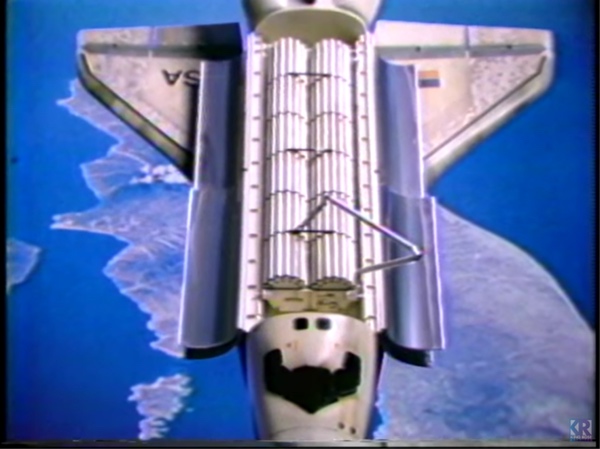 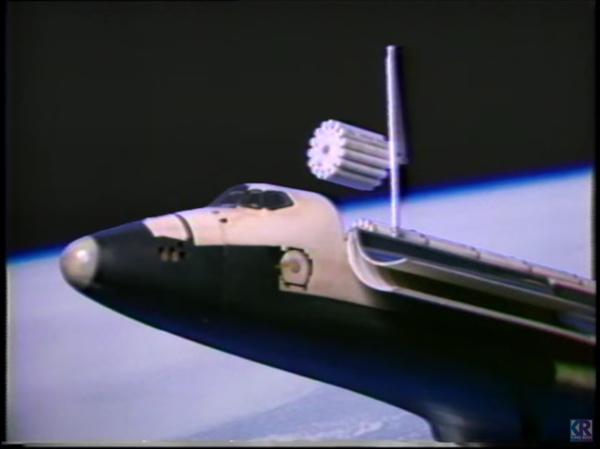  Stills from an animated video produced around 1980 proposing a constellation of orbiting missile launchers for destroying Soviet ICBMs in flight. This concept was rejected in favor of directed energy weapons when Ronald Reagan approved the Strategic Defense Initiative in 1983. Later, after directed energy weapons proved difficult to develop, SDI focused on the "Brilliant Pebbles" concept that was similar to this one. |
The quest for an anti-ballistic missile shield
Although the United States had spent considerable amounts of money in the 1950s and 1960s trying to develop a missile defense system, the difficulty of the task proved too daunting. In 1972, the United States and Soviet Union signed the Anti-Ballistic Missile (ABM) Treaty, which forbade the deployment of new anti-missile systems. The United States completed a single system in Grand Forks, North Dakota, and immediately shut it down. The Soviets had a limited system surrounding Moscow.
Some Soviet military leaders believed that the Americans would nevertheless develop a new ABM system despite the treaty. But after signing the ABM Treaty, the United States largely gave up on ABM technology development. By the mid-1970s ABM development was coming to a halt, with decreasing funding, and progress on anti-missile systems was minimal during President Jimmy Carter’s administration.
The ABM Treaty only forbade the deployment of anti-missile weapons—it did not prohibit testing or development (with some caveats), a loophole both sides exploited. In the United States, some former military and government officials began advocating for space-based anti-missile defenses involving orbiting interceptor weapons (see “Forces of darkness and light,” The Space Review, December 10, 2018.)
 In 1982, a non-government group attached to the Heritage Foundation produced a report advocating for space-based missile defense. (credit: Heritage Foundation) |
Around 1981, when Ronald Reagan took office, scientists at the Lawrence Livermore National Laboratory in California (among them physicist Edward Teller, the so-called “father of the H-bomb”), along with researchers at other federal labs and a handful of military and civilian policymakers, began looking at “directed energy” weapons—which shoot beams instead of bullets—as a way to neutralize an increasing Soviet advantage in launchers and missiles. A space activist even publicly advocated this approach in a 1981 article titled “Lase the Nukes.” In American national security circles, directed energy weapons soon began to eclipse the concept of orbiting interceptor missiles.
Reagan liked the idea, and in a televised speech on national security in March 1983, he announced his plan to build a “defensive shield” to “make nuclear weapons obsolete,” essentially changing the nation’s strategic posture from offense to defense. The proposal was immediately attacked by Democrats in Congress, who called it unworkable, and Senator Ted Kennedy who tagged it with the moniker “Star Wars.” Despite the skeptics, funding for missile defense increased dramatically, amounting to nearly $3 billion a year by 1986.
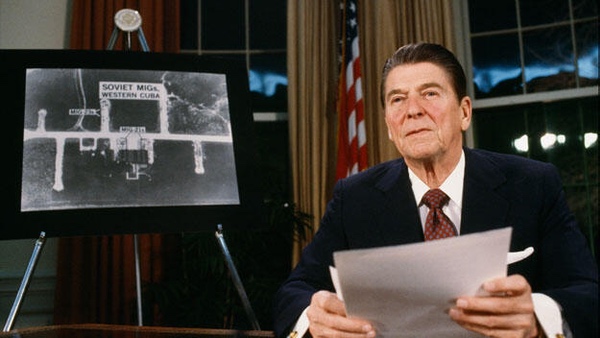 President Ronald Reagan delivered a speech from the Oval Office in March 1983 announcing what became the Strategic Defense Initiative. |
At the time, Allen Thomson was a senior analyst working for the CIA’s Office of Scientific and Weapons Research. He had studied other Soviet military research programs, including efforts to develop directed energy weapons and sensors for space-based submarine detection. In the summer after Reagan’s Star Wars speech, Undersecretary of Defense Fred Iklé requested a CIA study on how the Soviets might respond. The work fell to Thomson and two other analysts.
“The resulting study,” he recalls, “basically said that both politically and technically, the Soviets had a very wide range of options for responding to foreseeable U.S. SDI developments.” They could build more ICBMs, seek to thwart the American missile shield, or try to drum up international opposition to the American plan. “There was some recognition that the USSR might be financially strapped if it had to initiate new major weapons systems. But there was no indication that it would be unable to respond,” Thomson says.
Notably, the Soviet Union did not respond to the American SDI program with a space-based anti-missile program of their own. Bart Hendrickx points out that the Soviets did consider an orbiting ABM system similar to an American program of the late 1980s known as Brilliant Pebbles, but they rejected the concept. “It looks like the Russians concluded well before the start of SDI that a space-based missile shield was unrealistic… and unaffordable as well,” Hendrickx explained. This conclusion created problems for the Soviet leadership. Why did the Americans pursue a space-based anti-missile shield that Soviet scientists and engineers believed was impossible?
As the prominent planetary scientist and Mikhail Gorbachev advisor Roald Sagdeev wrote in his 1994 memoir The Making of a Soviet Scientist, “If Americans oversold [the Strategic Defense Initiative], we Russians overbought it.”
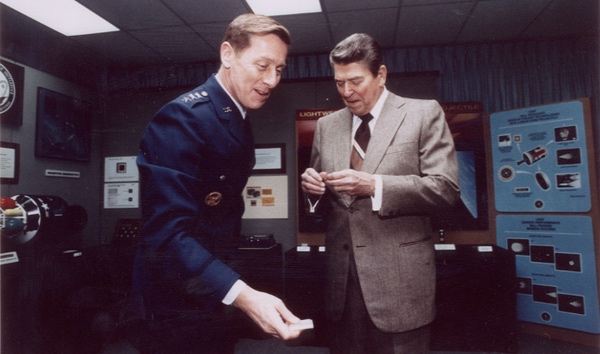 Lieutenant General James Abrahamson, who ran the SDI program showing President Ronald Reagan projects to protect SDI satellites from attack. (credit: Wikimedia Commons) |
Misread intentions
From the perspective of many Soviet scientists and military and political leaders, for the second time in a little over a decade the Americans seemed to be pursuing a nonsensical space program, and Soviet military and political leaders sought to make sense of it. Their conclusions were not always rational. Paranoid fantasies weren’t uncommon among senior Soviet generals, according to Peter Westwick, a history professor at the University of California at Santa Barbara who has written about science during the Cold War. “They thought that maybe the [US] space shuttle was going to be doing shallow dives into the atmosphere and deploying hydrogen bombs,” he says (see “Target Moscow: Soviet suspicions about the military use of the American Space Shuttle (part 1),” The Space Review, January 27, 2020, and part 2, February 3, 2020.)
| “The shuttle really scared the Soviets big-time because they couldn’t figure why you would need a vehicle like that, one that made no economic sense,” Siddiqi explains. “So they figured that there must be some unstated military rationale for the vehicle.” |
Asif Siddiqi agrees that the Soviets misinterpreted US intentions for the space shuttle: “To the Soviets, the shuttle was the big thing. It was a sign to them that the Americans were about to move war into space.” Never mind the official explanation—that the spaceplane, which made its debut in 1981, was meant to provide routine access to orbit. It could also be used to launch classified satellites for US defense agencies.
“The shuttle really scared the Soviets big-time because they couldn’t figure why you would need a vehicle like that, one that made no economic sense,” Siddiqi explains. “So they figured that there must be some unstated military rationale for the vehicle, for example, to deliver and recover large space-based weapons platforms, or to bomb Moscow.” The Soviets responded to the perceived threat by building their own space shuttle, Buran, which ended up being retired in 1993 after just one flight.
Shortly after Reagan’s speech, the Soviet Academy of Sciences was asked to assess whether a space-based missile shield was feasible. Evgeny Velikhov, a prominent physicist, led the study group. Their conclusion, according to Westwick, was, “We looked at it, we studied it, we determined that it wouldn’t work.” But other Soviet scientists were more alarmist, and succeeded in convincing military and political leaders that even if the SDI wasn’t an effective missile shield, it could be used offensively to hit targets on the ground.
The idea of lasers shooting down at Soviet territory from orbit was truly terrifying. According to Westwick, the theories that floated through the Kremlin about the real purpose of the SDI got batty: “Selective political assassination. Say the Politburo is standing outside on May Day and a single laser could take them all out… These things are overhead, they’re invisible, but with zero warning they could zap you.”
 President Ronald Reagan announced his Strategic Defense Initiative program in March 1983. The proponents for the Skif weapons system used this announcement to gain approval for Skif development. Skif was intended to shoot down American SDI satellites from orbit. |
Skif shifts into high gear
In 1981, the KB Salyut design bureau had been transferred to Energia from Chelomei’s design bureau. Skif and Kaskad were already underway at Energia, which was also developing a space shuttle and a large rocket to put it in orbit. Now that KB Salyut was part of Energia, the Skif and Kaskad projects were shifted internally to KB Salyut. (In 1993 KB Salyut became part of Khrunichev.)
Reagan’s 1983 SDI announcement was an instant kick in the pants for the Soviet space weapons program, giving bureaucrats in the aerospace design bureaus the political ammunition they needed to convince the Politburo to increase funding for Skif and Kaskad, which could be used to target the space-based elements of Reagan’s missile shield. Skif and Kaskad would be capable of going after American orbiting anti-ballistic missile satellites. “These were just two of a plethora of ASAT systems that the USSR worked on in the 1980s,” Hendrickx explained, and other ASAT weapons were also proposed to attack SDI satellites. In 2016 he published a paper in the Journal of the British Interplanetary Society outlining the many Soviet anti-satellite programs of that era titled “Naryad-V and the Soviet Anti-Satellite Fleet.”
The rubles started flowing for actual flight hardware, but Kaskad never left the drawing board. Skif, however, shifted into high gear. Soviet engineers working on Skif now found themselves like the dog that finally catches the car—what does he do with it? Skif was going to be an incredibly complicated spacecraft. According to a 2015 Russian space encyclopedia with new information on Skif:
In the course of the work [engineers] had to face significant technical difficulties. So, for example, all the “regular” target equipment (laser and supporting and control systems) existed only in the form of “mock-ups,” [or] at best - experimental ground samples. All electrical systems had to be created from scratch, because the requirements for speed and accuracy were an order of magnitude, or even two, higher than for the systems that existed at that time. The main developers were clearly not ready to create such a complex spacecraft. Over time, the understanding came that the creation of such complexes must begin with the solution of simpler fundamental tasks.
According to the 2015 encyclopedia, the original plan had been to use a “continuous-wave gas laser” built by NPO Energomash, whose core business was the production of powerful liquid-fuel rocket engines. Presumably, this was a hydrogen fluoride laser, the only type of laser that Energomash worked on, drawing from its experience in developing fluorine-based rocket engines. A history of Energomash published in 2004 said it had done its laser work as a subcontractor to NPO Astrofizika, a major Soviet laser design bureau that most likely was the prime contractor for the Skif laser.
However, the hydrogen fluoride laser turned out to be too complex, and it was abandoned in favor of two alternatives. One was a CO2 laser developed for a system called “Dreif,” a nautical term meaning “drift” or “drifting.” Dreif was originally designed to be mounted in a modified Il-76MD cargo aircraft to shoot down American reconnaissance balloons. “Dreif” was also a term applied to balloons drifting across the sky, hence its use for the airborne anti-balloon program. The laser for Skif was apparently developed by NPO Astrofizika with KMZ Soyuz serving as a subcontractor.
Another option was a laser developed by the Central Design Bureau of Chemical Automatics (KBKhA), which also manufactured rocket engines. Sources disagree on some of the details, such as whether it was a CO or CO2 laser, although it was probably CO2, like Dreif.
| Skif-D grew into a Frankenstein’s monster of a spacecraft: 40 meters long, more than 4 meters in diameter, and weighing 95 metric tons, more massive than NASA’s Skylab space station. |
According to the encyclopedia of Soviet and Russian space systems, the plan was to fly both of these lasers on a Skif demonstration mission, with the Dreif laser as the main one, and KBKhA’s as an “auxiliary laser.” The two-laser combination was too heavy for a Proton rocket and was apparently the reason why designers switched to the much more powerful Energia. The need to operate the Dreif laser both automatically and in a space environment prompted substantial redesign. It also required the construction of extensive testing infrastructure.
In August 1984, the new spacecraft was approved and designated “Skif-D,” with the “D” standing for “demonstration.” This approval came only from the Ministry of General Machine Building, which oversaw the space and missile industry, and approval from the Central Committee of the Communist Party did not come until January 1986.
Meanwhile, US scientists and engineers were having their own problems with space-based lasers. As research proceeded on projects like Zenith Star, which investigated the problems of placing a two-megawatt chemical laser in orbit, the challenges of building and launching such systems became clearer. SDI funded studies of particle beams and an X-ray laser that would use a nuclear explosion to set it off, but none of these projects ever came close to being deployed. By 1986, the SDI leadership was already shifting its attention away from lasers and toward small “kinetic kill vehicles” that could bring down enemy missiles by crashing into them—a more conventional interceptor concept that had predated Reagan’s 1983 speech.
The American shift from fewer, large satellites with directed energy weapons to many small satellites equipped with interceptor missiles undercut the justification for the Soviet Skif system. The Soviets, though, stayed the course, and kept working on the demonstration version of their space-based laser, with a target launch date of early 1987.
The Energia rocket, named after its design bureau, was being built to carry the new Buran space shuttle into orbit, meaning that two big projects were now directly competing for resources and launch vehicles. Energia could carry 95 tons to space, enough to lift Skif-D. To keep costs down, engineers looked for other existing hardware designs to modify and incorporate, including a so-called “functional block,” the main section of the TKS spacecraft, which had originally been designed to carry crews and cargo to the canceled Almaz military space stations and would later also serve as the basis for the add-on modules of the Mir space station (as well as the the Zarya/FGB module of the ISS.) They also borrowed a payload module from the TKS.
Skif-D grew into a Frankenstein’s monster of a spacecraft: 40 meters (131 feet) long, more than 4 meters (13 feet) in diameter, and weighing 95 metric tons (210,000 pounds), more massive than NASA’s Skylab space station. The system consisted of what the Russians called a functional block and a payload module. The functional block—what Americans might refer to as a spacecraft bus—was equipped with small rocket engines to place the vehicle into its final orbit. It also included a power system using solar panels borrowed from the TKS spacecraft. The payload module carried carbon dioxide tanks and two 1.2-megawatt turbogenerators to produce the laser’s power, as well as the heavy rotating turret that pointed the beam. The spacecraft was built long and thin so that it could fit on the side of the Energia, attached to its central fuel tank.
Designing a laser to work in orbit was a major engineering challenge. A handheld laser pointer is a relatively simple, static device, but a big gas-powered laser is like a roaring locomotive. Powerful turbogenerators “pump” the carbon dioxide to the point where its atoms become excited and emit light at a specific wavelength. Not only do the turbogenerators have large moving parts, the gas used in the formation of the laser beam gets very hot and has to be vented. Moving parts and exhaust gases pose problems for spacecraft—particularly one that has to be pointed very precisely—because they induce motion. The Skif engineers developed a system to minimize the force of the expelled gas by sending it through deflector vanes, which they referred to as “trousers.” But the vehicle still required a complex control system to damp out motions caused by the exhaust gases, the turbogenerator, and the moving laser turret. When firing, the entire spacecraft would point at the target, with the turret making fine adjustments.
The system was complicated enough that by 1985 the designers knew they would need more than one launch to test its components. Skif-D1 would prove out the basic spacecraft structure in 1987, while the laser itself wouldn’t fly until Skif-D2 in 1988. Around the same time, another, related spacecraft went into development. Designated Skif-Stilet (“Scythian-Stiletto”), it was to be equipped with another existing, less powerful, infrared laser based on an operational ground system. Skif-Stilet would only be able to blind the optics of enemy satellites, but Skif would have enough energy to destroy them.
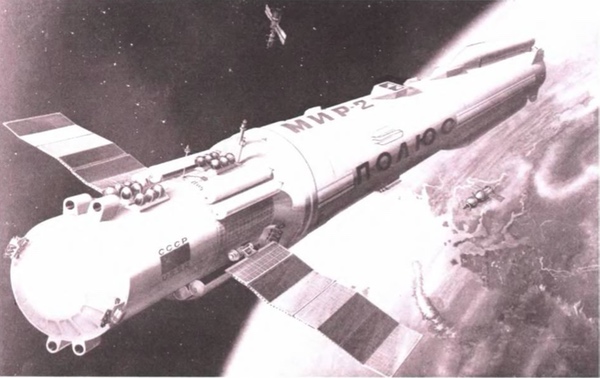 Artist impression of the Skif spacecraft in orbit. The "functional block" containing propulsion, power, and guidance systems, is on the left. The payload module with the lasers is on the right. Also visible at left are the targets that would be deployed and tracked in orbit. |
From Skif-D to Skif-DM
Work on these projects was proceeding at a furious pace throughout 1985 when an unexpected opportunity arose. The Buran shuttle had fallen behind schedule, and wouldn’t be ready in time for the planned first launch of the Energia rocket in 1986. The rocket’s designers were considering launching a dummy Skif payload instead. Launch was scheduled for fall 1986, and the plan was that this would not impact the planned launch of Skif-D1 in summer 1987. According to the encyclopedia, everybody involved in the project did not believe that the 1986 deadline was achievable.
| According to Westwick, Gorbachev began challenging his advisers: “Maybe we shouldn’t be so afraid of SDI.” |
The space encyclopedia states that this change in plans quickly got worse. A week after the announcement about launching a dummy payload, Minister of General Machine Building Oleg Baklanov showed up at KB Salyut and said that just launching a “blank” on the first Energia would not be enough, that they had to demonstrate something more “meaty,” something that would operate for a week in orbit, otherwise it would be “undignified for such a space power as the USSR.” Although those working on the project did not believe they could assemble a “serious” payload in such a short period, work continued. A week later they were told that the payload now had to operate for one month in orbit.
They quickly drew up plans for a vehicle that would test the functional block’s control system and additional components, like the gas ejection vents and a targeting system consisting of a radar and a low-power fine pointing laser that was separate from the big chemical laser. They labeled the spacecraft Skif-DM for “demonstration modification.” It was significantly lighter than Skif-D1, at only 80 metric tons, and did not carry the primary lasers. Despite the orders that the new vehicle not affect the work on the pre-existing planned vehicle, it inevitably led to a slowdown of Skif-D1.
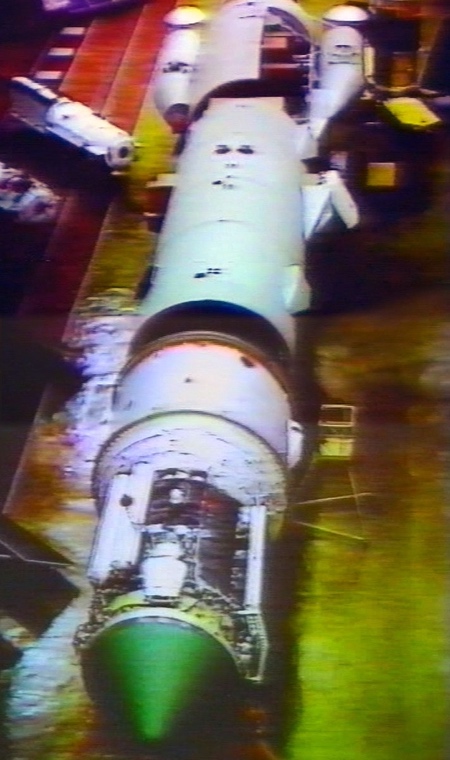 Video screenshot of the Skif-DM spacecraft. The "functional block" is at front, serving as what American space engineers usually refer to as a spacecraft bus. It was adapted from existing space hardware and provided propulsion, power, and guidance in orbit. The lasers would be mounted in the long cylindrical payload module but were not included in the Skif-DM version. During the first and only launch, the functional block was supposed to flip the entire spacecraft 180 degrees so that it was pointed up and the engines were pointed down. However, a software error led to the spacecraft flipping end over end several times before pointing down, and its engines forced it into the atmosphere. (credit: buranarchive.space) |
Racing the clock
Meeting such a tight deadline had a human cost. At one point, more than 70 firms within the Soviet aerospace industry were working on Skif. In his history of the project, Lantratov quotes from an article by Yuri Kornilov, the lead designer for Skif-DM at the Khrunichev Machine Building Factory: “As a rule, no excuses were accepted—not even the fact that it was almost the same group of people who, at that time, were performing the grandiose work associated with the creation of Buran. Everything took a back seat to meeting the deadlines assigned from the top.”
The designers realized that if they launched this huge craft into space, then expelled large amounts of carbon dioxide, American intelligence analysts would quickly figure out that the gas was intended for a laser. So they switched to a combination of xenon and krypton for the Skif-DM venting test. These gases would interact with ionospheric plasma around the Earth, and the spacecraft would appear to be part of a civilian geophysics experiment. Skif-DM would also be equipped with small inflatable balloon targets, mimicking enemy satellites, that would be jettisoned in flight and tracked with the radar and the pointing laser.
The launch of the demonstration satellite slipped to 1987, partly because the pad facility had to be modified from a test stand to a full-up launch pad for the Energia. In addition, the rocket assigned to the flight (designated 6S) had originally only been built for test firings and had to be modified to an operational launch vehicle designated 6SL. The delay had a critical impact on the project’s political fortunes.
In 1986, Mikhail Gorbachev, who had been General Secretary of the Communist Party for only a year, was already advocating the sweeping economic and bureaucratic reforms that would come to be known as perestroika, or “restructuring.” He and his allies in the government were intent on reining in what they saw as ruinous levels of military spending, and had become increasingly opposed to expensive military space projects. According to Westwick, Gorbachev began challenging his advisers: “Maybe we shouldn’t be so afraid of SDI.” The Soviet leader acknowledged that the American SDI plan was dangerous, says Westwick, but warned that his country was becoming obsessed with it.
Lantratov originally wrote that in January 1987, with Skif-DM’s launch just weeks away, Gorbachev’s allies in the Politburo pushed through an order limiting what could be done during the demonstration flight. The spacecraft could be launched into orbit, but could not test the gas venting system or deploy any of the tracking targets. The number of experiments was reduced. However, the 2015 encyclopedia claims that the order forbade any experiments at all to prevent the spacecraft from being interpreted as a space weapon.
In February 1987, the Skif-DM was mated to its Energia rocket as the booster lay horizontally inside a vast assembly building at the Baikonur Cosmodrome in Kazakhstan. At the factory in Moscow, technicians had painted “Mir-2” onto the front, facing outward from the launch vehicle. At Baikonur, technicians also painted “Polyus” onto the side of the spacecraft. “Polyus” was a late name for the program, and was intended for public consumption when the spacecraft was in orbit—a cover story for the weapon. Hendrickx notes that the plan at that time was to use Energia to build a follow-on space station after Mir. According to Lantratov, Mir-2 may have been less an attempt to fool foreign spies about the mission’s true purpose than it was an advertisement for the new project they wanted to build.
| The massive spacecraft tumbled end over end for two full revolutions, then stopped with its nose pointing down toward Earth. In the rush to launch such a complicated spacecraft, the designers had missed a tiny software error. |
The big launch vehicle and payload was rolled out to the launch pad in late February and spent three months there undergoing checks. Hendrickx wrote about this in detail in his history of Buran. A late order came down from leadership for several of the targets to be removed while the vehicle was on the pad, but spacecraft engineers pointed out the dangers of interacting with a fueled rocket, and the order was canceled.
If the skies were clear at any point during this time, American reconnaissance satellites certainly photographed the big rocket and maybe even gathered enough detail for American intelligence analysts to read the words on the spacecraft.
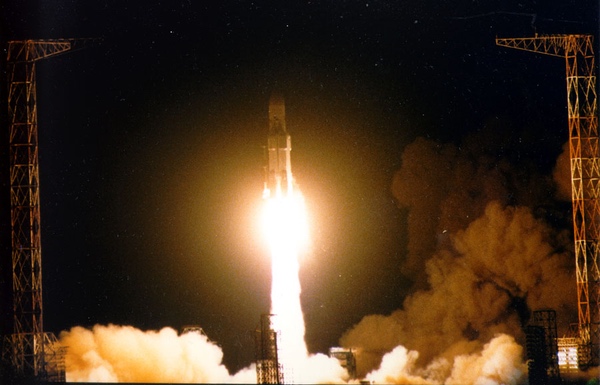 The Skif-DM was launched in May 1987 and failed to reach orbit. It was to be followed by the Skif-D1 and Skif-D2 spacecraft about a year apart. However, the program was canceled after this failure. (credit: buranarchive.space) |
Launching the monster
On the night of May 15, 1987, Energia’s engines lit and the giant rocket climbed into the sky. Whereas most launches from Baikonur head for an orbit inclined 52 degrees to the equator, Skif traveled farther north, on a 65-degree inclination. If the worst happened, this heading would keep rocket stages or pieces of debris—or the Skif-DM itself—from falling on foreign territory. The goal was for a 64.6 degree, 280-kilometer orbit.
The Energia rocket performed flawlessly on its first flight, gaining speed as it rose and arced out toward the northern Pacific. But the kluged nature of the Skif–DM test spacecraft, along with all the compromises and shortcuts, had ordained its doom. The satellite’s functional block had originally been designed for a Proton launcher, where it would be mounted under a payload shroud, so for aerodynamic reasons it was mounted near the top of the payload attached to the Energia. It would jettison its protective shroud before separating from the rocket. Once the spacecraft separated from its booster, it was supposed to flip around to point toward space, with the control block’s engines facing downward toward Earth, ready to fire and push it into orbit. It would also roll 90 degrees as well. Payload fairing separation occurred as planned at 3 minutes and 32 seconds into the flight, at an altitude of 90 kilometers.
After continuing its ascent, Skif-DM separated on cue and the spent Energia fell away. Then the entire 40-meter-long spacecraft began its gentle pitch maneuver. Its tail end—actually the front of the spacecraft—swung up through 90 degrees, through 180 degrees…then kept going. The massive spacecraft tumbled end over end for two full revolutions, then stopped with its nose pointing down toward Earth. In the rush to launch such a complicated spacecraft, the designers had missed a tiny software error. The engines fired, and Skif-DM headed back into the atmosphere it had just escaped, quickly overheating and breaking into burning pieces over the Pacific Ocean. The Soviet press agency TASS reported the loss of a “dummy satellite.”
In the West, the debut of the Energia super-rocket was reported as a partial success, since the launcher itself operated perfectly; it was the satellite that had failed. The US government almost certainly had intelligence sensors pointed at the rocket as it flew, but what the CIA or other agencies concluded about the payload remains classified.
The failure of the Skif program, combined with its immense expense, gave opponents in Gorbachev’s government the ammunition they needed to kill it. Further Skif flights were summarily canceled. Hardware already being prepared on the ground was either scrapped or shoved to the sides of giant warehouses.
In his history of the project, Lantratov quoted Yuri Kornilov, the Skif-DM lead designer: “Of course, no one received any prizes or awards for their feverish, two-year-long, under-the-deadline work. The hundreds of teams that had created Skif were not given an award or a word of thanks.” In fact, some were reprimanded or demoted after the Skif-DM failure.
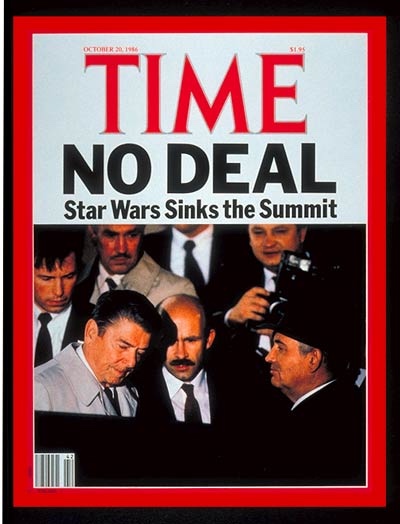 The Strategic Defense Initiative became a contentious topic during arms control negotiations in the 1980s. Many Soviet scientists—like their Western counterparts—believed that it was unworkable. But the official Soviet government position was to oppose SDI. |
Skif’s legacy
We still don’t know the entire story. “Even today there’s a lot of sensitivity about the whole program,” says Siddiqi, who has recently written a paper about how various parts of the Soviet government responded to SDI. “Russians don’t like to talk too much about it. And our understanding of Soviet responses to SDI still remains murky. It’s clear that there was a lot of internal debate within the Soviet military-industrial elite about the effectiveness of space weapons. And the fact that the Soviets came so close to actually launching a weapon platform suggests that the hardliners were in the driver’s seat. It’s scary to think what might have happened if Polyus had actually made it to orbit.”
Another interesting thought experiment is to posit what might have happened had Reagan never announced the SDI, which had derailed arms control negotiations. Would the two leaders have gone further than they did if SDI had not become a point of contention?
| SDI did not help bankrupt the Soviet Union, which was already bankrupting itself. |
CIA analyst Allen Thomson’s 1983 report on possible Soviet responses to SDI accurately predicted several of the actions that the Soviet Union ultimately took, including the Soviet diplomatic offensive against it as well as the possibility that the Soviets would develop systems to attack American SDI satellites. The paranoid fantasies of some Soviet military and political leaders about what SDI could do, such as destroying targets on the ground using lasers, were the kinds of reactions that only became clearer after the end of the Cold War. (The CIA report can be downloaded here.)
Historian Pavel Podvig has tried to determine SDI’s ultimate impact on the Soviet Union and the Cold War. According to a 2017 paper by Podvig, SDI did not deter the Soviet Union from fielding more ICBMs; if they thought that SDI would have worked, they would have shifted their weapons to other systems, like cruise missiles. Skif was already in the works before SDI, and Podvig argues that it was an extension of existing programs rather than a clear response to Reagan’s program. Nevertheless, it failed to reach orbit and there was no follow-on anti-SDI space program, and no clear indication that Soviet weapons or space spending increased as a result of SDI. SDI did not help bankrupt the Soviet Union, which was already bankrupting itself. The Soviet response to SDI was primarily diplomatic and in the realm of arms control rather than military, Podvig wrote.
Skif was an ambitious project, but never accomplished its mission, and was quickly canceled and suppressed, unknown until decades later. Given the current state of Russian politics, it will likely be decades until we can learn even more about this period when the superpowers planned to put weapons in the skies above.
Note: we are using a new commenting system, which may require you to create a new account.
